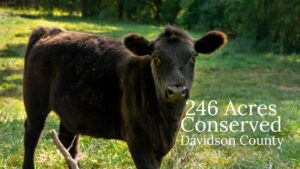
by Crystal Cockman
February 24, 2016
When walking in the woods it’s always a pretty site to come upon a fern valley along a stream or creek. The moist conditions along a pristine stream or damp wetland area making for the right conditions for a sea of vivid green on the forest floor. One interesting and beautiful fern that is found in more open conditions is the climbing fern. Lygodium is the genus of the group of plants known as climbing ferns. There are only about 40 species worldwide, with most of them occurring in the tropics.

Climbing ferns differ from typical ferns as their name suggests – their fronds form vines that twine around other vegetation and can be anywhere from 10 to 40 feet long. Even among fern species, they are really delicate and beautiful. Climbing ferns are rare in many places, as they require moisture, high light, and very acidic soil. They also have a unique distinction of being the first plant in the United States protected by law. In 1869, Connecticut passed a law preventing its collection for Christmas decorations.
Unfortunately there are also some nonnative and invasive climbing ferns. Japanese climbing fern (Lygodium japonicum) is native to eastern Asia and Australia. It was introduced to the United States for ornamental purposes in the 1930s. They are listed as a noxious week in Alabama and in Florida. It is not widely found in North Carolina yet. Old World climbing ferns (Lygodium microphyllum) are another invasive in the United States that is native to Africa, Southeast Asia and Australia. It is also a big problem in the state of Florida, suggested by some to be the most problematic invasive in the state.
Both Japanese and Old World climbing ferns can form dense stands that outcompete native vegetation. During prescribed burns, these invasive ferns can carry the fire up to the canopy of trees, which is more likely to result in tree mortality. Some specific insects have been released to help control the nonnative ferns in state parks, which has shown some promising results. Old World climbing fern is a problem weed in some areas of North Carolina. Hopefully if you see a climbing fern species it will be the native one, but if you think you may have found the invasive one you can contact the North Carolina Invasive Plant Council at northcarolinaipc@gmail.com or to the NC Department of Agriculture and Consumer Services at 1-800-206-9333 or newpest@ncagr.gov.